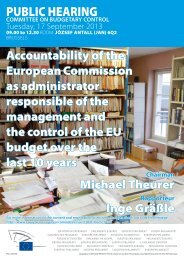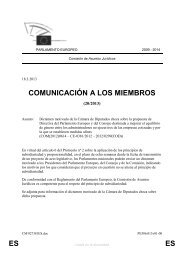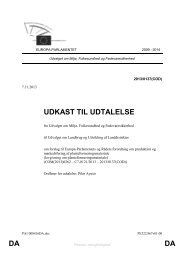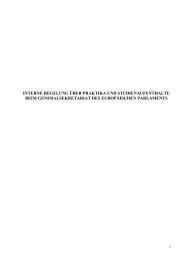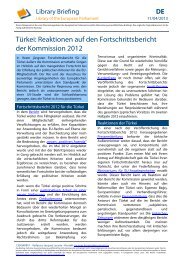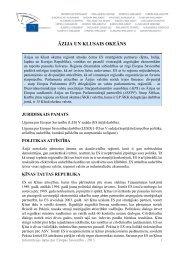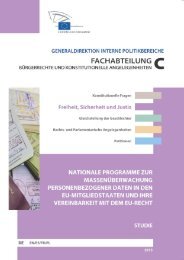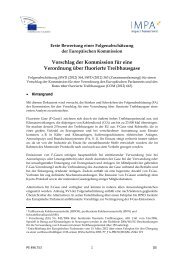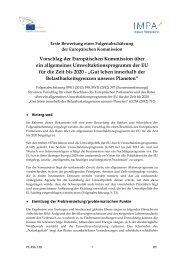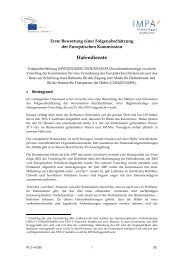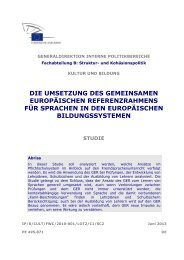Link to the study - European Parliament - Europa
Link to the study - European Parliament - Europa
Link to the study - European Parliament - Europa
Create successful ePaper yourself
Turn your PDF publications into a flip-book with our unique Google optimized e-Paper software.
Nuclear Decommissioning: Management of Costs and Risks<br />
____________________________________________________________________________________________<br />
personnel recruitment shortages (in 15 <strong>to</strong> 20 years half of <strong>the</strong> workforce, in 30 <strong>to</strong> 40 years <strong>the</strong><br />
complete workforce is exchanged once).<br />
This general view is detailed fur<strong>the</strong>r in later chapters.<br />
The following general conclusions can be drawn:<br />
A <strong>to</strong>tal of 88 reac<strong>to</strong>rs are currently in <strong>the</strong>ir shutdown stage in <strong>the</strong> EU.<br />
The size distribution, operating time of <strong>the</strong> reac<strong>to</strong>rs and shutdown periods in <strong>the</strong> EU are varying<br />
widely.<br />
France, Germany and <strong>the</strong> UK are <strong>the</strong> most affected countries in <strong>the</strong> EU facing decommissioning<br />
projects.<br />
Currently only roughly 10 % of <strong>the</strong> reac<strong>to</strong>rs in shutdown state have reached <strong>the</strong>ir final<br />
decommissioning stage while <strong>the</strong> vast majority is in different stages of decommissioning. Most<br />
of <strong>the</strong> finalized projects are located in Germany.<br />
2.2. TECHNICAL BASIS OF DECOMMISSIONING<br />
Decommissioning a reac<strong>to</strong>r takes place under controlled technical conditions and brings <strong>the</strong> facility<br />
in<strong>to</strong> a state that does not require limitations any more (<strong>to</strong> a state 'below any regula<strong>to</strong>ry concern' or by<br />
a complete removal) is caused by <strong>the</strong> remaining radioactive content that still is left in <strong>the</strong> facility even<br />
if <strong>the</strong> highly radioactive spent fuel has been removed. The following provides a basic understanding<br />
of <strong>the</strong> sources and types of radioactivity that play a role in decommissioning.<br />
2.2.1. Activation and contamination of <strong>the</strong> nuclear reac<strong>to</strong>r during operation<br />
Radioactivity is generated in a nuclear reac<strong>to</strong>r by two different processes: nuclear fission and neutron<br />
activation.<br />
Nuclear reac<strong>to</strong>rs generate electricity by means of neutron-induced fission of fissile materials such as<br />
Uranium-235 or Plu<strong>to</strong>nium-239 in<strong>to</strong> fission products (such as Cesium-137) and utilize <strong>the</strong> heat<br />
generated in this process. Fission generates more neutrons than are necessary <strong>to</strong> keep <strong>the</strong> fission<br />
process steady. So a large portion of <strong>the</strong> generated neutrons are captured in materials such as:<br />
Control rods,<br />
The cooling agent (such as cooling water) and neutron moderating agents (such as boric acid),<br />
The reac<strong>to</strong>r vessel steel and <strong>the</strong> reac<strong>to</strong>r vessel internals (such as <strong>the</strong> outer metal part of fuel rods,<br />
steel structural parts, measuring equipment), and in<strong>to</strong><br />
The bio shield 2 .<br />
2<br />
Bio shield: a concrete structure outside <strong>the</strong> reac<strong>to</strong>r vessel that captures neutrons that leave <strong>the</strong> reac<strong>to</strong>r<br />
vessel <strong>to</strong> <strong>the</strong> outside.<br />
37



